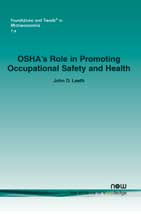OSHA's Role in Promoting Occupational Safety and Health
By John D. Leeth, Bentley University, Department of Economics, USA, JLeeth@Bentley.edu
Abstract
When OSHA was established, proponents believed it would dramatically improve the safety and health of American workers. During the forty years of its existence, workplace fatalities and nonfatal injuries and illnesses have fallen but OSHA is not the major cause of this decline. Changes in the industrial mix of workers and improvements in safety technology have combined with expanded employer incentives unrelated to OSHA to decrease worker injuries and illnesses. The financial incentives for employers to expand expenditures on worker safety and health created by the labor market, states' workers' compensation insurance programs, and the legal system swamp the meager incentives created by OSHA.
This survey examines OSHA in light of the other forces affecting workplace safety in the United States to generate a set of policy recommendations for how it can best use its limited resources to improve worker safety and health. No evidence exists that expanding the total number of inspections or the average amount of fines for noncompliance would improve its effectiveness significantly. OSHA can best complement the other pillars of the US safety policy system by providing information to workers about possible hazards, particularly health-related hazards, and by gearing inspections toward worksites where dangers are hard to monitor and firms employing less mobile and less knowledgeable workers. It should continue to offer consultation services to smalland medium-sized firms and encourage firms to establish management systems addressing worker safety and health issues.
OSHA's Role in Promoting Occupational Safety and Health
OSHA's Role in Promoting Occupational Safety and Health examines the four pillars of the US safety policy system with a focus on the most recent effort - the Occupational Safety and Health Administration (OSHA). The goal is to determine how OSHA could best use its limited resources to improve worker safety and health in light of incentives already created through the labor market, state workers' compensation insurance programs, and the legal system. After an introduction, the next section develops the general economic model of production and the workplace when there are inevitable risks to safety and health. The third and fourth sections present the institutional details of OSHA and the nature of workplace fatalities and nonfatal injuries in the United States. The monograph moves on to examine the evolving enforcement of OSHA regulations over the forty years of its existence and the corresponding empirical estimates of its effectiveness in improving worker safety and health. The next three sections discuss the other three pillars of the US safety policy system, detailing their strengths and weaknesses in generating appropriate safety incentives. The following sections evaluate the likely impact on worker safety of expanding OSHA enforcement power and assess the cost-effectiveness of OSHA in its entirety and some of its regulations individually. The monograph concludes with recommendations on how best to improve OSHA's effectiveness in promoting worker safety and health. Finally, the author shows that no evidence exists that by magnifying OSHA's enforcement powers, either by increasing the frequency of inspections or by raising the level of fines for noncompliance, worker safety and health would improve dramatically.
